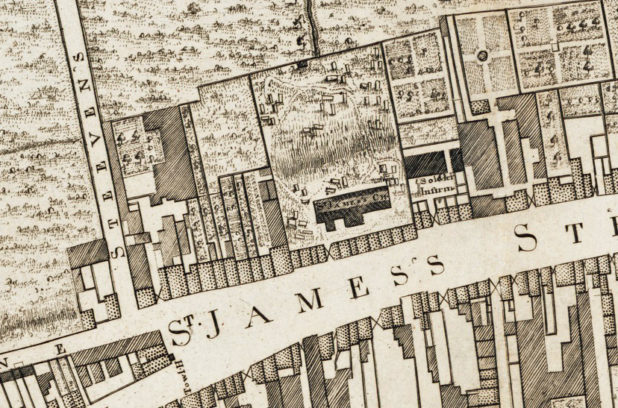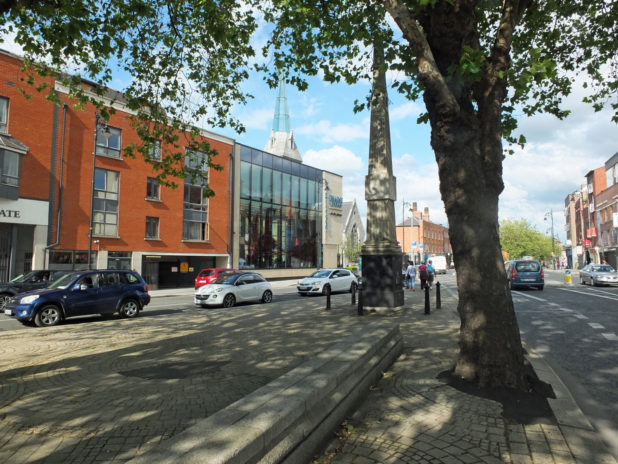The Story of St James’s Fair – This highly researched article is on the subject of St James Fair, a fascinating read in the habits and rituals of our people in times past. Please take a look!
Sean J Murphy
Throughout Europe the annual fair was a very important event in the calendar. The fair was the occasion not just of buying and selling goods, but of celebration, eating and drinking, music and song, playing games and unfortunately recreational violence also. The poor in particular could seek relief from the poverty and drudgery of their everyday lives through the exciting events of the fair.
Ireland’s great fairs include Puck Fair in Co Kerry and the Lammas Fair in Antrim, both still in existence. In Dublin there were formerly annual fairs in Donnybrook in August and at the site of St John’s Well in Kilmainham in June. In James’s Street of course there was the famous St James’s Fair, held for a week around the time of the saint’s feast day on 25 July, in the vicinity of St James’s Church. While well remembered locally, St James’s Fair receives only a few mentions in fair histories, so it would be a good idea to take a closer look at its origins and eventual decline.
Unlike Donnybrook Fair whose establishment in 1204 is documented, we do not have a foundation charter for St James’s Fair, but it could well have been established about the same time as Donnybrook. Our earliest account of St James’s Fair appears in a work by Richard Stanihurst published in 1577. This author notes that city merchants had the fair limited in size as a result of competition from English, French and Flemish merchants, who sold their wares there ‘so dog-cheap’.
After the Reformation in the sixteenth century, Irish Catholics continued the tradition of celebrating ‘Pattern’ (from ‘patron/pátrún) days in honour of saints, despite the disapproval of the Protestant authorities. Although St James’s Church in James’s Street came under Protestant control after the Reformation, Catholics still held their festivities beside the church. Catholics also continued to bury their dead in St James’s Graveyard and a custom grew of visiting and decorating the graves of family members around the time of the saint’s feast-day.
St James’s Fair continued to thrive in the eighteenth century and retained a reputation for public disorder. In June 1738 a critical petition concerning the fair was placed before Dublin City Council. It was noted that from ‘time immemorial’ St James’s Fair had been held every 25th of July in James’s Street ‘by authority of the city’ but that it had been accompanied by ‘tumults and riots, and sometimes . . . murder’. The Council therefore ordered that St James’s Fair should ‘be discontinued for the future’ and that the Lord Mayor should issue a proclamation to this effect.
This edict clearly did not bring an end to St James’s Fair, which continued to be held until at least the early decades of the nineteenth century. The businessman and author, Walter Thomas Meyler, who was born in St Catherine’s Parish in 1813, recalled that when he was a child, ‘St James’s Fair . . . formed my gala day of the year, and securely did I hoard my halfpennies for the occasion’. He provides an engaging pen picture of the Fair, ‘with its range of stands covered with baskets of cherries, gooseberries, gilt gingerbread, toys, tin whistles, drums, tops, horses and whips’.
The memoirs of the actor and dramatist John O’Keeffe, born in Dublin 1747, include an interesting description of the aforementioned custom of decorating graves in St James’s Graveyard on St James’s Day. He wrote that it was the custom for ‘relations and friends of those buried in St James’s Churchyard to dress up the graves with flowers, cut paper, scripture phrases, garlands, chaplets and a number of other pretty and pious devices’. Warburton, Whitelaw and Walsh’s history of Dublin, published in 1818, describes these decorations as forming ‘effigies or images of all the persons who have been buried in the same grave’. These authors also noted that St James’s Graveyard was ‘the general cemetery of the lower classes’, who believed that the Pope offered up prayers on St James’s Day for the souls of all those buried there.
These accounts, which underscore the associations of St James’s Graveyard with Catholics and the poor, were describing St James’s Fair in its final years, as the festival does not appear to have lasted beyond the 1820s. The June celebrations at St John’s Well in Kilmainham continued until the 1840s, while the great fair at Donnybrook survived until the 1860s.
The Protestant St James’s Church is today converted into the Pearse Lyons Distillery, while on the opposite side of James’s Street, Catholic St James’s Church continues its parochial role. St James’s Graveyard, behind the old Protestant Church, is now owned by Dublin City Council and is currently closed to the public while works are in progress.
The most prominent surviving reminder of St James’s Fair is of course the island or open space where today the Fountain stands, possibly marking the site of an original St James’s Well. It is here that the stallholders and revellers of the past would have held sway around the 25th of July each year. There have been recent efforts to revive the St James’s Day custom of decorating graves in the Graveyard, so who knows, a St James’s Fair might yet be seen in the street again, minus the disorder of course!
For further articles on the history of St James’s Church and Graveyard, see https://ucd.academia.edu/SeanMurphy











Do you have any information re Coachbuilders in this area?
Regards
“The most prominent surviving reminder of St James’s Fair is of course the island or open space where today the Fountain stands, possibly marking the site of an original St James’s Well. ”
I read somewhere, that there was an underground public convenience there